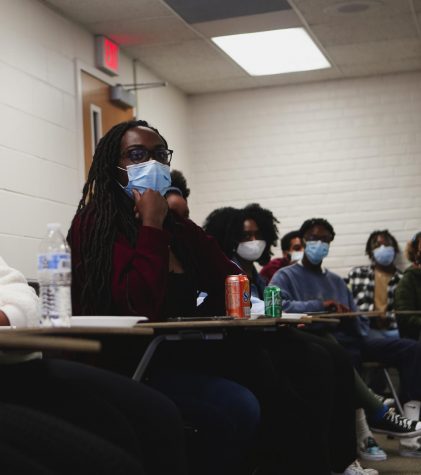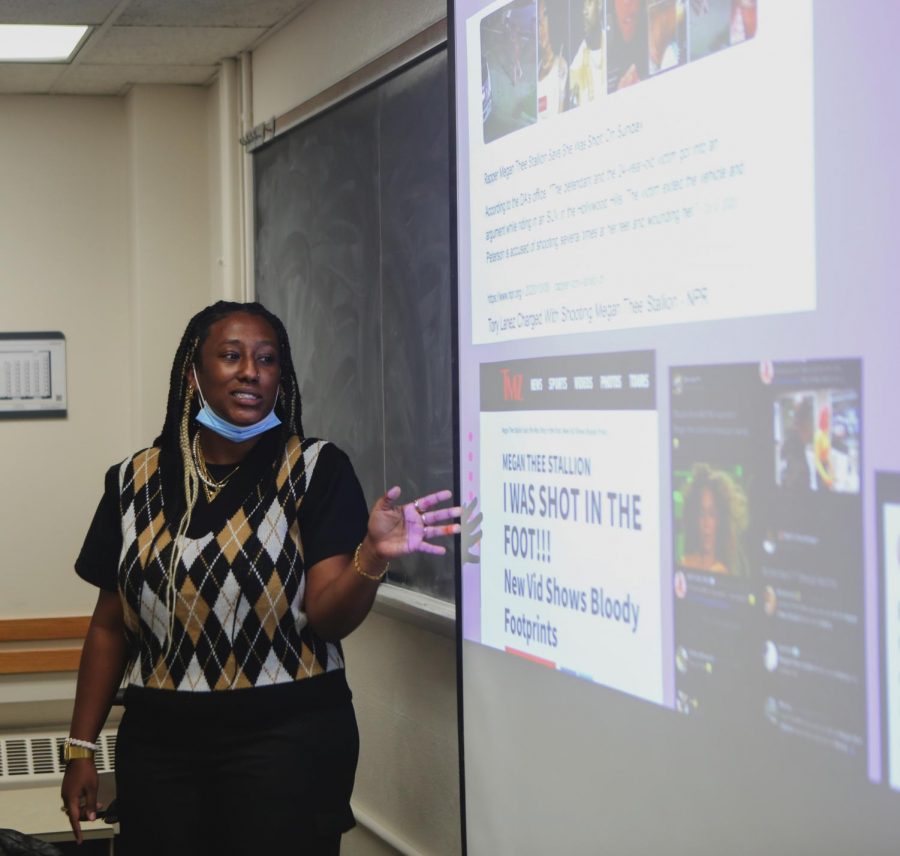Historically, the media has played an undeniable role in framing and spreading racist stereotypes that have set up narratives to create the misogynoir that is present in today’s media.
Around 25 students showed up sporting Nikes, Vans, Dr. Martens, sweaters and hoodies, with mostly women in attendance, gathered at Amundson Hall on a cold night on Oct. 14 to discuss the negative portrayals of Black women in today’s film, television and pop culture.
Hosted by Black Motivated Women (BMW), a group whose mission is to promote sisterhood and build community through cultural education, University of Minnesota students and BMW members Gwen King-Lunde and Bethany Tamrat led the discussion, advertised through Instagram as “Misogynoir in Media.”
King-Lunde, a third-year student double majoring in African American and African Studies and Sociology, led the discussion, along with third-year student Tamrat, a double major in Business/Marketing and Urban Studies. To kick off the event, the group played Catch Phrase, an icebreaker game that consisted of Black-themed categories such as food, music, people, hairstyles and Black cinema.
Created to shine a light on relevant topics in the Black communities, King-Lunde saw a lack of space in mainstream discourse to bring these conversations of Black history and culture among Black women to the surface.
“I realized representation is going backward for Black women today, but in the ‘90s we had a lot of good representation for dark-skinned Black women,” King-Lunde said. The shows in question, “Living Single,” “Sister Sister,” “The Parkers” and “Moesha,” to name a few, depicted Black women from multiple perspectives while giving them the autonomy to be themselves.
Misogynoir in Media
So, let’s talk about it.
Defined as “the ways anti-Black and misogynistic representation shape broader ideas about Black women, particularly in visual culture and digital spaces,” the term “misogynoir” was coined by Moya Bailey, a Northeastern University professor and Black feminist scholar.
The hosts hoped the event would teach attendees about how to identify specific examples of misogynoir so people can call it out when they see it. The event was also meant to be a call to action, to examine how we can all “work together to stop and eliminate the stereotypes that media perpetuate,” Tamrat said.
“This was a chance to unify Black women and to share what Black women are experiencing on campus, so they don’t feel isolated — this gives us the opportunity to connect over our shared experiences at a public white institution,” Tamrat said.

The first topic students discussed were the many problematic tropes of Black women in the media, which involves the sapphire (the angry Black woman), the mammy (the overly nurturing Black woman), the jezebel (the hypersexual Black woman) and the strong Black woman.
The trope that Black women are vehemently angry without sense or direction transcends Tyler Perry’s film canon and makes its way into reality. This, they discussed, is how stereotypes persist. Students agreed that Hollywood superstar Taraji P. Henson has been casted as the sapphire in two of Tyler Perry’s films –– “Acrimony” and “I Can Do Bad All by Myself” –– in which she plays an unreasonably angry Black woman. However, as stated in the room’s discussion, Perry can be criticized as having a history of writing Black women in demeaning roles.
“Media is a very powerful tool and if people haven’t interacted with Black women in real life, they could start to believe the stereotypes they see on TV, which could speak to their subconscious biases toward Black women,” Pamela Gray, a second-year astrophysics student, said. Gray said she feels passionate about treatment of Black women and understanding and dismantling misogynoir in the media and in real life.
The group also discussed the mammy stereotype, a racial caricature that dates back to the Jim Crow era in which Black women were depicted on stage and in films as maids or slaves who were happy to be slaves. This role ignored the historical race-relations between Black women and white people, in which Black women lovingly took care of white families despite their own oppressed and disenfranchised position in society.
The role portrayed Black women as dark-skinned, overweight women who spoke in broken English. In fact, these characters were used to justify the subjugation of Black people because they were always smiling, despite their servitude status. This trope led to cultural implications that would affect how white people and others view Black women as servants or second-class citizens in comparison to them even today. Also, other cultural implications of the historical racist objectification of Black women have been normalized, so Black womens’ identities and creations have been appropriated by white women and beyond, both nationally and globally.
Another point of discussion was the Jezebel trope, which has created the stereotype that Black women are hypersexual and animalistic in their approach to romanticism. This trope has been utilized to justify the rape and sexual abuse of Black women during and after American slavery. The impact of the Jezebel character continues today and has been utilized to sexualize Black girls by controlling what they wear. For example, Black girls’ bodies and clothing are policed in schools because staff assume they are being promiscuous, which leads to their racial criminalization and racial victimization by the white gaze.
Historically, Black people have often been excluded from the mainstream media as actors, directors and writers, except for roles where they were subjected to playing caricatures.
The group discussed how images in pop culture reinforce racial stereotypes, which leads to the exploitation of Black women. An example of this was the exploitation of Kimberly “Sweet Brown” Wilkins, who survived a fire that was started in her apartment complex. Wilkins later became known as the “Ain’t nobody got time for that” lady because her follow-up interview with the press was turned into a meme online because of her voice and language.
Wilkins’ situation could be viewed as modern-day blackface because she was turned into a meme without context, which is similar to the caricatures that white filmmakers portrayed of Black people in media.
Historically, blackface has included white people speaking in broken English, wearing ragged clothes and presenting a joyous attitude toward the oppression of Black people in America. These performances imply that Black people did not mind being oppressed or enslaved.
Blackface was one of the most popular forms of artistic expression during the 1800s and 1900s, and it was pervasive. White people performed in blackface across America and it was the impetus of fanatically obscene fascination with Black people while not acknowledging Black people’s humanity or existence as people.
When the group discussed the strong Black woman trope, a conversation started about musician Tory Lanez allegedly shooting Megan Thee Stallion in her foot –– it is widely believed that Lanez shot her. When it was revealed that Lanez allegedly shot Stallion, she faced backlash from people on social media who gaslit her and denied her credibility.
This trope suggests that Black women can endure immeasurable pain without faltering; therefore, they should be expected to go on regardless of the difficulties they face. It dehumanizes Black women because it ignores the root of whatever conflict they are facing while also applying herculean strength upon their shoulders.
Another point of discussion was the appropriation and theft of Black women’s language (AAVE) and dance moves. Ebonics has been passed off as “Gen Z language,” which is another form of cultural genocide because it discredits the origniators of said language. They also talked about TikTok star Charli D’Amelio stealing the Renegade dance from Jalaiah Harman, a young Black girl from Atlanta.
This is one example of how white people steal culture from Black people while also “robbing Black people of their wealth,” King-Lunde said.
The last discussion centered around Black women in sports, including Serena Williams’ and Simone Biles’ negative portrayal in the media for various reasons. The Herald Sun’s cartoonist, Mark Knight drew a racist caricature of Williams, but the newspaper defended Knight’s drawing. The paper agreed with Knight, who claimed his drawing was not racist. The Australian Press Council also agreed that Knight used absurdity and exaggeration to make a point rather than a racial caricature. This is a form of racialized gaslighting that Black women often experience.
The three main goals for the event were first to teach those in attendance about misogynoir and second, to identify specific examples of misogynoir so people can call it out when they see it. The third goal was a call to action, which focused on identifying the issues while also asking, “How can we all work together to stop and eliminate the stereotypes that media perpetuate?” Tamrat said.
“We want to let Black women on campus know that Black Motivated Women is a safe space for them,” King-Lunde said. “They’re the ones we prioritize.”














A Gopher
Oct 28, 2021 at 4:20 pm
Can I updoot this comment twice?I went to an inner city Minneapolis high school with the highest rate of poverty and single motherhood. The numbskulls in this school would walk around and say things like “Why I gots to listen ta y’all, y’all ain’t got kids.” As though making a poor decision with your reproductive organs somehow beamed some special cosmic knowledge into your brain. I would overhear groups of girls convince other young, black girls not to go to college, literally “Guurrrllll, you ain’t gotta be ’bout all dhat school. Just getchu a man, getchu a baby, and getchu a check!” No matter what you think, these girls aren’t that stupid. They know that early motherhood leads to an immediate path of income from the government. It will, of course, not work out much later on in life, but many of these folks don’t think they’ll live much past 20 years old and they see that the present charms far outweigh the distant struggles. If you don’t believe me, why don’t you get out of your sheltered suburban experience and volunteer in the poorest high school or middle school you can find and actually listen to what these kids tell each other.
Tamrat
Oct 28, 2021 at 12:36 am
Rome wasn’t built overnight. While appreciating the highlight they put on this critical issue, let’s wait for what they are going to accomplish next. One at a time!
lostoncampus
Oct 27, 2021 at 2:42 pm
“Created to shine a light on relevant topics in the Black communities”
Did they discuss Single Motherhood? And how its a direct path to Govt dependency? That seems to be the #1 topic they NEED to address- Single mothers are breeding the hoodlums we see today roaming the streets mugging students, shooting each other- They all have Single black mothers-
Oh but stereotypes. . . . well, single teenage black mother with 3 kids on welfare isnt a stereotype- its Reality-